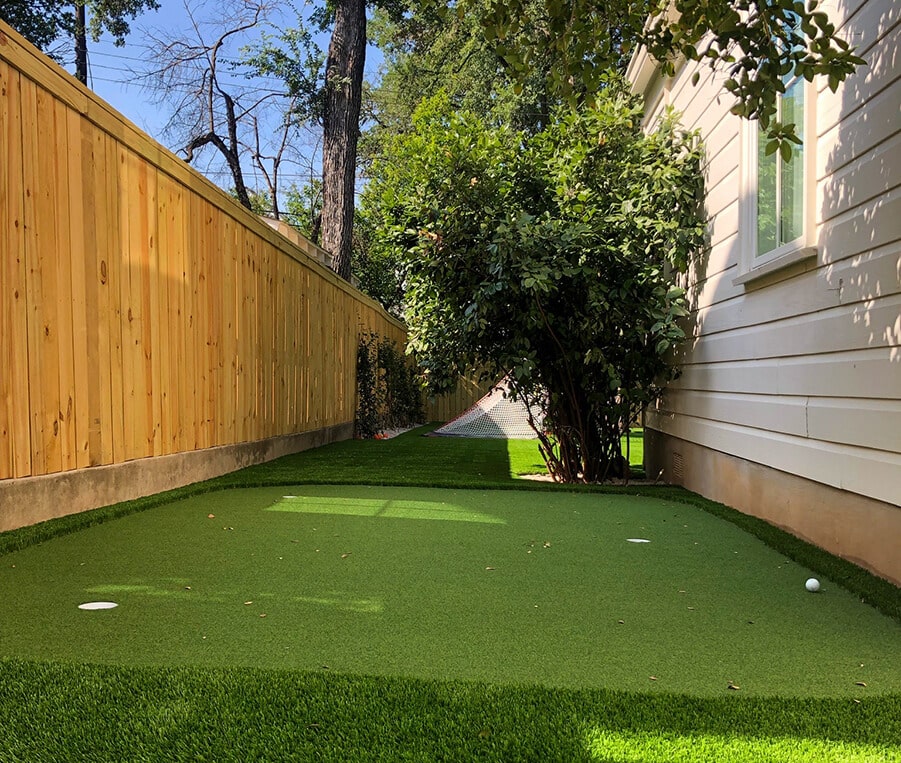LawnPop® Artificial Grass: Austin’s Green Solution for Sustainable Lawns

With the rising emphasis on sustainable living, homeowners are increasingly seeking environmentally-friendly solutions for their landscaping needs. Enter artificial grass. A popular alternative to traditional lawns, synthetic turf not only lends a lush, year-round green to your yard, but also boasts an impressive array of ecological advantages. From conserving precious water resources to eliminating the need for harmful pesticides, artificial grass is making its mark as a green solution in modern households. Its popularity underscores a conscious move towards practices that are kind to our planet without compromising on aesthetics or functionality.
Here are some of the key environmental advantages of installing artificial grass in your home:
Water Conservation
In an age where water scarcity looms large, conserving every drop is more vital than ever. Lawns, though picturesque, can be thirsty landscapes. Natural lawns, especially in regions prone to drought, guzzle gallons of water to maintain their verdant sheen. However, an innovative solution has surfaced in the form of synthetic turf. By replicating the lush aesthetics of a well-maintained lawn without the associated water demands, artificial grass has emerged as a champion for water conservation. With only the sporadic need for cleaning, its water requirements are a mere fraction of those for a natural lawn, making it a compelling option for the eco-conscious homeowner.
Reduced Chemical Use
Natural landscapes, while undeniably beautiful, come with hidden environmental costs. Many homeowners, in their bid to achieve that perfectly manicured lawn, resort to a cocktail of fertilizers, pesticides, and herbicides. These potent chemicals, besides bolstering the lawn’s health, have a darker side. As they make their way into local waterways, they wreak havoc on aquatic ecosystems and pose significant risks when they seep into our drinking water. But here’s the silver lining: artificial grass. This green alternative does away with the need for such chemicals entirely, offering not just aesthetic appeal but also an environmentally responsible choice for the modern homeowner.
Decreased Emissions
The hum of a lawnmower on a weekend morning might sound like a hallmark of suburbia, but it’s a sound that comes with an environmental price. Traditional lawn care, often reliant on gas-powered tools such as mowers, edgers, and trimmers, contributes significantly to greenhouse gas emissions. These machines, while efficient, spew pollutants into the atmosphere, adding to the environmental burden. However, a shift is in motion. The adoption of artificial grass promises not just verdant lawns but also a tangible reduction in emissions. By eliminating the regular need for these tools, artificial turf stands as a beacon for those looking to trim down their carbon footprint.
Erosion Control
Erosion, a subtle yet insidious force, has long been a concern for homeowners and environmentalists alike. Particularly in areas prone to slopes or where natural turf struggles to take root, the steady wear and tear of soil can lead to significant land degradation and unwanted run-offs. Enter artificial grass. More than just a low-maintenance landscaping solution, synthetic turf plays a pivotal role in anchoring the soil firmly in place. By offering a protective barrier against the elements and foot traffic, artificial grass serves as a sturdy shield, ensuring the terrain remains undisturbed and preserving the natural topography of the land.
Durability and Longevity
For those who desire a lawn that stands the test of time, synthetic turf offers an answer. Unlike its natural counterpart, which can falter under adverse conditions or require constant attention to remain vibrant, high-quality artificial grass promises longevity. With the resilience to endure everything from intense sun to trampling feet, it’s a choice that combines aesthetics with endurance. This durability means homeowners can enjoy a consistently green lawn without the frequent need for replanting or landscaping tweaks. In the long run, it becomes not only an investment in visual appeal but also a testament to sustainable choices that reduce environmental footprints.
No Grass Clippings
Maintaining a pristine lawn comes with its fair share of byproducts – notably, grass clippings. While these green fragments might seem harmless, their disposal poses a deeper environmental concern. When amassed in landfills, these clippings undergo anaerobic decomposition, leading to the release of methane, a greenhouse gas far more potent than carbon dioxide in trapping heat. The environmental implications are undeniable. However, there’s a silver lining in the form of synthetic grass. Opting for this alternative eliminates the generation of grass clippings altogether. Thus, homeowners not only rid themselves of disposal hassles but also contribute to a reduction in greenhouse gas emissions.
Reduced Allergens
The simple pleasure of a walk in the garden can be marred for many by the relentless grip of allergies. Grass pollen, a common culprit, triggers sneezing, itchy eyes, and a myriad of other allergic reactions in sensitive individuals. But what if the garden could be an oasis, free from such allergens? Artificial turf offers this very solace. Designed to mimic natural grass minus the pollen production, synthetic grass becomes a haven for those looking to enjoy outdoor spaces without the sniffles. As more households make the switch, they’re not only embracing an allergy-friendly garden but also fostering a healthier living environment.
No Overwatering
Striking the right balance in watering a lawn can be a delicate dance. Overzealous homeowners, in their pursuit of verdant expanses, often tip the scales, drenching their lawns more than required. This overwatering isn’t just a misstep in lawn care; it’s a tangible waste of a vital resource. Against this backdrop, synthetic turf shines as a beacon of efficiency. With no real thirst to quench, artificial grass maintains its lush appeal without a drop. This not only alleviates homeowners of the watering dilemma but also underscores a commitment to water conservation, ensuring that every drop counts in a world where water is increasingly precious.
While there are clear environmental benefits to artificial grass, it’s important to also consider potential drawbacks. For instance, the production of synthetic turf requires resources, and old turf needs to be disposed of, potentially ending up in landfills. The turf can also get hot in direct sunlight, which might increase local temperatures slightly.
Considering both the pros and cons can help homeowners make informed decisions based on their specific needs, local environment, and personal preferences.
Discover Your Dream Lawn with LawnPop!
Experience the transformation that LawnPop® Artificial Grass brings to any landscape. Situated right in the heart of Austin, Texas, we are dedicated to giving you a lawn that’s not only beautiful but sustainable and smart. Tired of incessant watering or battling with shaded patches? Imagine a lush, green expanse all year round, with minimal maintenance. Whether it’s a backyard retreat or a sprawling ballpark, our expertise remains unmatched. Connect with us today for a free estimate, and let’s make your lawn pop!
LawnPop® Artificial Grass
Sustainable Solutions
Austin, Texas
? Call Us: (512) 298-0933
? Email: Team@LawnPop.com




